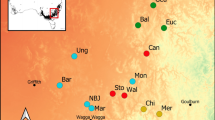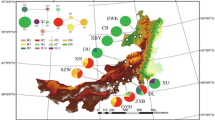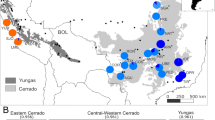Abstract
Local adaptation influences plant species’ responses to climate change and their performance in ecological restoration. Fine-scale physiological or phenological adaptations that direct demographic processes may drive intraspecific variability when baseline environmental conditions change. Landscape genomics characterize adaptive differentiation by identifying environmental drivers of adaptive genetic variability and mapping the associated landscape patterns. We applied such an approach to Sphaeralcea ambigua, an important restoration plant in the arid southwestern United States, by analyzing variation at 153 amplified fragment length polymorphism loci in the context of environmental gradients separating 47 Mojave Desert populations. We identified 37 potentially adaptive loci through a combination of genome scan approaches. We then used a generalized dissimilarity model (GDM) to relate variability in potentially adaptive loci with spatial gradients in temperature, precipitation, and topography. We identified non-linear thresholds in loci frequencies driven by summer maximum temperature and water stress, along with continuous variation corresponding to temperature seasonality. Two GDM-based approaches for mapping predicted patterns of local adaptation are compared. Additionally, we assess uncertainty in spatial interpolations through a novel spatial bootstrapping approach. Our study presents robust, accessible methods for deriving spatially-explicit models of adaptive genetic variability in non-model species that will inform climate change modelling and ecological restoration.





Similar content being viewed by others
References
Aitken SN, Yeaman S, Holiday JA, Wang T, Curtis-McLane S (2008) Adaptation, migration, or extirpation: climate change outcomes for tree populations. Evol Appl 1:95–111
Alberto FJ, Aitken SN, Alía R, González-Martínez SC, Hänninen H, Kremer A et al (2013) Potential for evolutionary responses to climate change—evidence from tree populations. Glob Change Biol 19:1645–1661
Barboza PS (1995) Nutrient balances and maintenance requirements for nitrogen and energy in desert tortoises (Xerobates agassizii) consuming forages. Comp Biochem Physiol A 112:537–545
Barrett RDH, Schluter D (2008) Adaptation from standing genetic variation. Trends Ecol Evol 23:38–44
Beatley JC (1974) Phenological events and their environmental triggers in Mojave Desert ecosystems. Ecology 55:856–863
Beaumont MA, Balding DJ (2004) Identifying adaptive genetic divergence among populations from genome scans. Mol Ecol 13:969–980
Benjamini Y, Hochberg Y (1995) Controlling the false discovery rate: a practical and powerful approach to multiple testing. J R Stat Soc B 57:289–300
Bothwell H, Bisbing S, Therkildsen NO, Crawford L, Alvarez N, Holderegger R, Manel S (2013) Identifying genetic signatures of selection in a non-model species, alpine gentian (Gentiana nivalis L.), using a landscape genetic approach. Conserv Genet 14:467–481
Bragg JC, Supple MA, Andrew RL, Borevitz JO (2015) Genomic variation across landscapes: insights and applications. New Phytol. doi:10.1111/nph.13410
Breed MF, Stead MG, Ottewell KM, Gardner MG, Lowe AJ (2013) Which provenance and where? Seed sourcing strategies for revegetation in a changing environment. Conserv Genet 14:1–10
Breshears DD, Cobb NS, Rich PM, Price KP, Allen CD, Balice RG et al (2005) Regional vegetation die-off in response to global-change type drought. Proc Natl Acad Sci USA 102:15144–15148
Brooks ML, Minnich RA (2006) Fire in the Southeastern deserts bioregion. In: Sugihara NG, van Wagtendonk JW, Fites-Kaufman J, Shaffer KE, Thode AE (eds) Fire in California ecosystems. University of California Press, Berkeley, pp 391–414
Brooks ML, D’Antonio CM, Richardson DM, Grace JB, Keeley JE, DiTomaso JM et al (2004) Effects of invasive alien plants on fire regimes. Bioscience 54:677–688
Brown JH, Valone TJ, Curtin CG (1997) Reorganization of an arid ecosystem in response to recent climate change. Proc Natl Acad Sci USA 94:9729–9733
Dai A (2013) Increasing drought under global warming in observations and models. Nat Clim Change 3:52–58
Daly C, Halbleib M, Smith JI, Gibson WP, Doggett MK, Taylor GH, Curtis J, Pasteris PA (2008) Physiographically-sensitive mapping of temperature and precipitation across the conterminous United States. Int J Climatol 28:2031–2064
Davis MB, Shaw RG (2001) Range shifts and adaptive responses to quaternary climate change. Science 292:673–679
De Kort H, Vandepitte K, Bruun HH, Closset-Kopp D, Honnay O, Mergeay J (2014) Landscape genomics and a common garden trial reveal adaptive differentiation to temperature across Europe in the tree species Alnus glutinosa. Mol Ecol 23:4709–4721
De Mita S, Thuillet AC, Gay L, Ahmadi N, Manel S, Ronfort J, Vigouroux Y (2013) Detecting selection along environmental gradients: analysis of eight methods and their effectiveness for outbreeding and selfing populations. Mol Ecol 22:1383–1399
De Villemereuil P, Frichot E, Bazin E, Francois O, Gaggiotti OE (2014) Genome scan methods against more complex models: when and how much should we trust them? Mol Ecol 23:2006–2019
Dolédec S, Chessel D, Gimaret C (2000) Niche separation in community analysis: a new method. Ecology 81:2914–2927
Drake KK, Esque TC, Nussear KE, DeFalco LA, Scoles-Sciulla SJ, Modlin AT, Medica PA (2015) Desert tortoise use of burned habitat in the eastern Mojave Desert. J Wildl Manage 79:618–629
Dray S, Dufour AB (2007) The ade4 package: implementing the duality diagram for ecologists. J Stat Softw 22:1–20
Ellstrand NC (2014) Is gene flow the most important evolutionary force in plants? Am J Bot 101:737–753
Evans LM, Slavov GT, Rodgers-Melnick E, Martin J, Ranjan P, Muchero W et al (2014) Population genomics of Populus trichocarpa identifies signatures of selection and adaptive trait associations. Nat Genet 46:1089–1096
Excoffier L, Hoffer T, Foll M (2009) Detecting loci under selection in a hierarchically structured population. Heredity 103:285–298
Feder JL, Nosil P (2010) The efficacy of divergence hitchhiking in generating genomic islands during ecological speciation. Evolution 64:1729–1747
Fensholt R, Sandholt I (2003) Derivation of a shortwave infrared water stress index from MODIS near- and shortwave infrared data in a semiarid environment. Remote Sens Environ 87:111–121
Ferrier S, Drielsma M, Manion G, Watson G (2002) Extended statistical approaches to modelling spatial pattern in biodiversity in northeast New South Wales. II. Community-level modelling. Biodivers Conserv 11:2309–2338
Ferrier S, Manion G, Elith J, Richardson K (2007) Using generalized dissimilarity modelling to analyze and predict patterns of beta diversity in regional biodiversity assessment. Divers Distrib 13:252–264
Fitzpatrick MC, Keller SR (2015) Ecological genomics meets community level modelling of biodiversity: mapping the genomic landscape of current and future environmental adaptation. Ecol Lett 18:1–16
Fitzpatrick MC, Sanders NJ, Normand S, Svenning JC, Ferrier S, Gove AD et al (2013) Environmental and historical imprints on beta diversity: insights from variation in rates of species turnover along gradients. Proc Biol Sci 280:20131201
Foll M, Gaggiotti O (2008) A genome scan method to identify selected loci appropriate for both dominant and codominant markers: a Bayesian perspective. Genetics 180:977–993
Fordham DA, Akcakaya HR, Araújo MB, Elith J, Keith DA, Pearson R et al (2012) Plant extinction risk under climate change: Are forecast range shifts alone a good indicator of species vulnerability to global warming? Glob Change Biol 18:1357–1371
Fournier-Level A, Korte A, Cooper MD, Nordborg M, Schmitt J, Wilczek AM (2011) A map of local adaptation in Arabidopsis thaliana. Science 334:86–89
Hagerty BE, Nussear KE, Esque TC, Tracy CR (2011) Making molehills out of mountains: landscape genetics of the Mojave Desert tortoise. Landsc Ecol 26:267–280
Hancock AM, Brachi B, Faure N, Horton MW, Jarymowycz LB, Gianluca Sperone F, Toomajian C, Roux F, Bergelson J (2011) Adaptation to climate across the Arabidopsis thaliana genome. Science 334:83–86
Hereford R, Webb RH, Longpre CI (2004) Precipitation history of the Mojave Desert region, 1893–2001. US Geological Survey Fact Sheet 117-03
Herrera CM, Bazaga P (2008) Population-genomic approach reveals adaptive floral divergence in discrete populations of a hawk moth-pollinated violet. Mol Ecol 17:5378–5390
Holderegger R, Herrmann D, Poncet B, Gugerli F, Thuiller W, Taberlet P et al (2008) Land ahead: using genome scans to identify molecular markers of adaptive relevance. Plant Ecol Divers 1:273–283
Holderegger R, Buehler D, Gugerli F, Manel S (2010) Landscape genetics of plants. Trends Plant Sci 15:675–683
Hubbard T, Conta DM, Smith SE (1993) Seed production and pollen tube growth following cross- and self-pollinations in Sphaeralcea laxa Woot. & Standl. Southwest Nat 38:331–335
Hufford K, Mazer S (2003) Plant ecotypes: genetic differentiation in the age of ecological restoration. Trends Ecol Evol 18:147–155
Inman RD, Nussear KE, Esque TC, Vandergast AG, Hathaway SA, Wood DA, Barr KR, Fisher RN (2014) Mapping habitat for multiple species in the Desert Southwest. U.S. Geological Survey Open-File Report 2014-1134. doi:10.3133/ofr20141134
IPCC (Intergovernmental Panel on Climate Change) (2013) Climate change 2013: the physical science basis. Contribution of Working Group I to the Fifth Assessment Report of the Intergovernmental Panel on Climate Change. Cambridge University Press, Cambridge
Jay F, Manel S, Alvarez N, Durand EY, Thuiller W, Holderegger R et al (2012) Forecasting changes in population genetic structure of alpine plants in response to global warming. Mol Ecol 21:2354–2368
Johnson R, Stritch L, Olwell P, Lambert S, Horning M, Cronn R (2010) What are the best seed sources for ecosystem restoration on BLM and USFS lands? Nativ Plants 11:117–131
Jones LC, Schwinning S, Esque TC (2014) Seedling ecology and restoration of blackbrush (Coleogyne ramosissima) in the Mojave Desert, United States. Restor Ecol 22:692–700
Joost S, Bonin A, Bruford MW, Després L, Conord C, Erhardt G, Taberlet P (2007) A spatial analysis method (SAM) to detect candidate loci for selection: towards a landscape genomics approach to adaptation. Mol Ecol 16:3955–3969
Jump AS, Peñuelas J (2005) Running to stand still: adaptation and the response of plants to rapid climate change. Ecol Lett 8:1010–1020
Kettenring KM, Mercer KL, Adams CR, Hines J (2014) Application of genetic diversity-ecosystem function research to ecological restoration. J Appl Ecol 51:339–348
Le Corre V, Kremer A (2012) The genetic differentiation at quantitative trait loci under local adaptation. Mol Ecol 21:1548–1566
Legendre P, Legendre L (2012) Numerical ecology, 3rd English edn. Elsevier Science BV, Amsterdam
Leimu R, Fischer M (2008) A meta-analysis of local adaptation in plants. PLoS One. doi:10.1371/journal.pone.0004010
Lesica P, Allendorf F (1999) Ecological genetics and the restoration of plant communities: mix or match? Restor Ecol 7:42–50
MacMahon JA (2000) Warm deserts. In: Barbour MG, Billings WD (eds) North American terrestrial vegetation. Cambridge University Press, Cambridge, pp 285–322
Manel S, Joost S, Epperson BK, Holderegger R, Storfer A, Rosenberg MS, Scribner KT, Bonin A, Fortin MJ (2010) Perspectives on the use of landscape genetics to detect genetic adaptive variation in the field. Mol Ecol 19:3760–3772
Manel S, Gugerli F, Thuiller W, Alvarez N, Legendre P, Holderegger R, Gielly L, Taberlet P (2012) Broad-scale adaptive genetic variation in alpine plants is driven by temperature and precipitation. Mol Ecol 21:3729–3738
Manion G, Fitzpatrick M, Lisk M (2014) Gdm01: create generalized dissimilarity models. R package version 1.0/r63. http://R-Forge.R-project.org/projects/gdm/
McCune B, Grace JB, Urban DL (2002) Analysis of ecological communities. MjM Software Design, Gleneden Beach
McKay J, Christian C, Harrison S, Rice K (2005) “How local is local”—a review of practical and conceptual issues in the genetics of restoration. Restor Ecol 13:432–440
Meyer SE, Pendleton BK (2005) Factors affecting seed germination and seedling establishment of a long-lived desert shrub (Coleogyne ramosissima: Rosaceae). Plant Ecol 178:171–187
Mijangos JL, Pacioni C, Spencer PBS, Craig MD (2015) Contribution of genetics to ecological restoration. Mol Ecol 24:22–37
Miriti MN, Rodríguez-Buriticá S, Wright SJ, Howe HF (2007) Episodic death across species of desert shrubs. Ecol 88:32–36
Moore ID, Grayson RB, Ladson AR (1991) Digital terrain modeling: a review of hydrological, geomorphological, and biological applications. Hydrol Process 5:3–30
Munson SM (2013) Plant responses, climate pivot points, and trade-offs in water limited ecosystems. Ecosphere. doi:10.1890/ES13-00132.1
Munson SM, Webb RH, Belnap J, Hubbard A, Swann DE, Rutman S (2012) Forecasting climate change impacts to plant community composition in the Sonoran Desert region. Glob Change Biol 18:1083–1095
Narum SR, Hess JE (2011) Comparison of FST outlier tests for SNP loci under selection. Mol Ecol Resour 11:184–194
Nicotra AB, Atkin OK, Bonser SP, Davidson AM, Finnegon EJ, Mathesius U (2010) Plant phenotypic plasticity in a changing climate. Trends Plant Sci 12:684–692
Oksanen J, Guillaume F, Roeland Kindt B, Legendre P, Minchin PR, O’Hara RB, Simpson GL, Solymos P, Stevens HH, Wagner H (2013) vegan: community ecology package. R package version 2.0-8. http://CRAN.Rproject.org/package=vegan
Orsini L, Vanoverbeke J, Swillen I, Mergeay J, De Meester L (2013) Drivers of population genetic differentiation in the wild: isolation by dispersal limitation, isolation by adaptation and isolation by colonization. Mol Ecol 22:5983–5999
Parmesan C (2006) Ecological and evolutionary responses to recent climate change. Annu Rev Ecol Evol Syst 37:637–669
Peakall R, Smouse PE (2012) GenAlEx 6.5: genetic analysis in Excel. Population genetic software for teaching and research-an update. Bioinformatics 28:2537–2539
Peres-Neto PR, Jackson DA (2001) How well do multivariate data sets match? The advantages of a Procrustean superimposition approach over the Mantel test. Oecologia 129:169–178
Pérez-Figueroa A, Garcia-Pereira MJ, Saura M, Rolán-Alvarez E, Caballero A (2010) Comparing three different methods to detect selective loci using dominant markers. J Evol Biol 23:2267–2276
Poncet BN, Herrmann D, Gugerli F, Taberlet P, Holderegger R, Gielly L et al (2010) Tracking genes of ecological relevance using a genome scan in two independent regional population samples of Arabis alpina. Mol Ecol 19:2896–2907
Reusch TBH, Wood TE (2007) Molecular ecology of global change. Mol Ecol 16:3973–3992
Richardson BA, Rehfeldt GE, Kim MS (2009) Congruent climate-related genecological responses from molecular markers and quantitative traits for western white pine (Pinus monticola). Int J Plant Sci 170:1120–1131
Rieseberg LH, Burke JM (2001) The biological reality of species: gene flow, selection, and collective evolution. Taxon 50:47–67
Salguero-Gómez R, Siewert W, Casper BB, Tielbörger K (2012) A demographic approach to study effects of climate change in desert plants. Philos Trans R Soc B 367:3100–3114
Sandquist DR, Ehleringer JR (1997) Intraspecific variation of leaf pubescence and drought response in Encelia farinosa associated with contrasting desert environments. New Phytol 135:635–644
Schoville SD, Bonin A, François O, Lobreaux S, Melodelima C, Manel S (2012) Adaptive genetic variation on the landscape: methods and cases. Annu Rev Ecol Evol Syst 43:23–43
Sexton JP, Hangartner SB, Hoffmann AA (2014) Genetic isolation by environment or distance: which pattern of gene flow is most common? Evolution 68:1–15
Sork VL, Aitken SN, Dyer RJ, Eckert AJ, Legendre P, Neale DB (2013) Putting the landscape into the genomics of forest trees: approaches for understanding local adaptation and population responses to changing climate. Tree Genet Genomes 9:901–911
St. Clair JB, Kilkenny FF, Johnson RC, Shaw NL, Weaver G (2013) Genetic variation in adaptive traits and seed transfer zones for Pseudoroegneria spicata (bluebunch wheatgrass) in the northwestern United States. Evol Appl 6:933–938
Steane DA, Potts BM, McLean E, Prober SM, Stock WD, Vaillancourt RE, Byrne M (2014) Genome-wide scans detect adaptation to aridity in a widespread forest tree species. Mol Ecol 23:2500–2513
Stingemore JA, Krauss SL (2013) Genetic delineation of local provenance in Persoonia longifolia: implications for seed sourcing for ecological restoration. Restor Ecol 21:49–57
Strasburg JL, Sherman NA, Wright KM, Moyle LC, Willis JH, Rieseberg LH (2012) What can patterns of differentiation across plant genomes tell us about adaptation and speciation? Philos Trans R Soc B 367:364–373
Svenning JC, Sandel B (2013) Disequilibrium vegetation dynamics under future climate change. Am J Bot 100:1266–1286
Thomassen HA, Cheviron ZA, Freedman AH, Harrigan RJ, Wayne RK, Smith TB (2010) Spatial modelling and landscape-level approaches for visualizing intra-specific variation. Mol Ecol 19:3532–3548
Thuiller W, Albert C, Araújo MB, Berry PM, Cabeza M, Guisan A et al (2008) Predicting global change impacts on plant species’ distributions: future challenges. Perspect Plant Ecol 9:137–152
Turner RM (1994) Mohave desertscrub. In: Brown DE (ed) Biotic communities: southwestern United States and northwestern Mexico. University of Utah Press, Salt Lake City, pp 157–168
Valladares F, Matesanz S, Guilhaumon F, Araújo MB, Balaguer L, Benito-Garzón M et al (2014) The effects of phenotypic plasticity and local adaptation on forecasts of species range shifts under climate change. Ecol Lett 17:1351–1364
Vandergast AG, Bohonak AJ, Hathaway SA, Boys J, Fisher RN (2008) Are hotspots of evolutionary potential adequately protected in southern California? Biol Conserv 141:1648–1664
Vandergast AG, Perry WM, Lugo RV, Hathaway SA (2011) Genetic Landscapes GIS Toolbox: tools to map patterns of genetic divergence and diversity. Mol Ecol Resour 11:158–161
Vandergast AG, Inman RD, Barr KR, Nussear KN, Esque TC, Hathaway SA et al (2013) Evolutionary hotspots in the Mojave Desert. Diversity 5:293–313
Vilas A, Pérez-Figueroa A, Caballero A (2012) A simulation study on the performance of differentiation-based methods to detect selected loci using linked neutral markers. J Evol Biol 25:1364–1376
Vitousek PM, Mooney HA, Lubchenco J, Melillo JM (1997) Human domination of earth’s ecosystems. Science 277:494–499
Walther GR, Post E, Convey P, Menzel A, Parmesan C, Beebee TJC et al (2002) Ecological responses to recent climate change. Nature 416:389–395
Acknowledgments
We thank F. Edwards [U.S. Bureau of Land Management (BLM), Las Vegas Field Office, NV], C. Lund (BLM, California State Office), and K. Harcksen and J. Fox (BLM, Arizona Strip Field Office, AZ) for funding support. Additional funding was provided by the U.S. Geological Survey, Priority Ecosystem Science Program, and the United States Department of the Interior, BLM Native Plant Materials Program. This manuscript was significantly improved by comments from Amy Vandergast and three anonymous reviewers. Any use of trade, product or firm names in this publication is for descriptive purposes only and does not imply endorsement by the United States government. Experiments described here comply with all rules and regulations pertaining to the land and resources where they were performed.
Author information
Authors and Affiliations
Corresponding author
Electronic supplementary material
Below is the link to the electronic supplementary material.
Rights and permissions
About this article
Cite this article
Shryock, D.F., Havrilla, C.A., DeFalco, L.A. et al. Landscape genomics of Sphaeralcea ambigua in the Mojave Desert: a multivariate, spatially-explicit approach to guide ecological restoration. Conserv Genet 16, 1303–1317 (2015). https://doi.org/10.1007/s10592-015-0741-1
Received:
Accepted:
Published:
Issue Date:
DOI: https://doi.org/10.1007/s10592-015-0741-1




